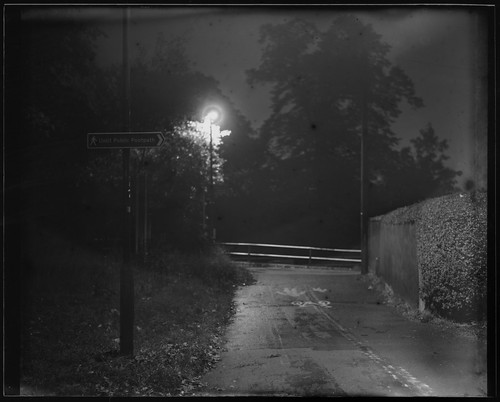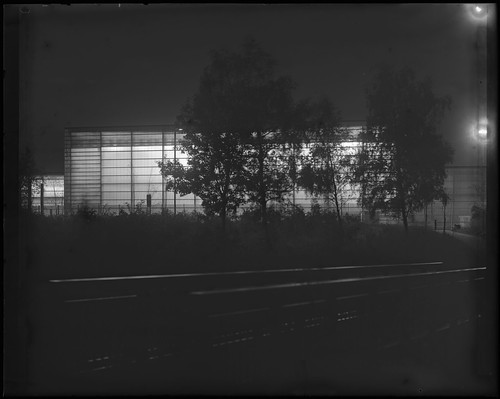 |
| Box of Panchromatic Photographic Plates produced for the Air Ministry |
In my post
Recent Glass Plate Work-part two I mentioned that 5x4 plates don't appear in auctions very often in comparison to other sizes. Since then I've only found one box of 5x4 inch glass plates, but one that's an interesting curiousity. The plates in the sealed box are described simply as 'Plates, Photographic Panchromatic'. The label is printed with the initials 'A. M.' which, with the crown symbol, stands for the
Air Ministry; the Air Ministry existed from 1918-1964 before being subsumed into the UK's Ministry of Defence. The box has a maker's identification number ('TE12') which could be used to discover which company made the plates, but this isn't the sort of information that can be readily found on the internet. The date of coating appears to be '12/5/34' (it's just possible that the partially stamped digit is a '5' for '54' but comparing it to the '5' present, it does look like a '3'). These are the oldest securely dated glass plates I have used (the box of
Mimosa Porträtyp-Antihalo plates might be older, but are not dated like this box).
As I wasn't expecting much from the plates at this age, I didn't do a test before shooting a couple of plates, on the same night as I shot some more
Ilford G.30 Chromatic plates. I stand developed all the plates in Rodinal 1:150 for 1 hour 20 minutes (using the dilution of 1:150 rather than 1:100 in an attempt to keep the contrast of the night scenes down). Having low expectations, I was surprised by the results, which were a little thin, but printable. What was also notable was the backing: on most other plates I've used this washes off during the developing process. I also usually soak the plates in water before stand development for 2-5 minutes, but with the Air Ministry plates, the backing is thick and gelatinous, and during the final wash stage I had to take each plate out of the wash individually and use my fingers to rub away the backing.
 |
Air Ministry plate, MPP Micro Technical Mk VI with Schneider Kreuznach Xenar 150mm f4.5 lens.
Scan from contact print. |
 |
Air Ministry plate, MPP Micro Technical Mk VI with Schneider Kreuznach Xenar 150mm f4.5 lens.
Scan from contact print. |
After the initial results, I decided to use one plate to make test exposures in order to determine a working exposure index. The box gives no indication of the original speed of the plates, but comparing the exposures of the first two plates against the results of Ilford G.30 Chromatic plates previously shot, I reckoned the Air Ministry plates to be around half as sensitive. For the test, I metered the scene at 6 EI, and made three successive exposures on the plate to give 6, 3 and 1.5 exposure indexes. It is a little hard to judge the results, partly as the background fog pulls up the shadow values, at 6 EI there is a lack of shadow detail, but the middle exposure at 3 EI looks to be printable (the image from the plate below is a scan from the negative).
 |
| Air Ministry plate test. Three successive exposures at 6 EI. |
I subsequently shot another couple of the Air Ministry plates at night, choosing for the first plate a difficult subject with the brightly lit building against a foreground which is almost featureless; the second plate, a longer exposure to use a smaller aperture for greater depth of field (18 minutes at f8) shows more effects of age on the plate. Apart from a few spots, all the plates show marks from the cardboard runners holding the edges of the plates in pairs in the wrapping, but generally, for glass plates which might be 79 years old, the results are impressive.
 |
| Air Ministry plate, MPP Micro Technical Mk VI with Carl Zeiss Jena Tessar 16.5cm f5.3 lens. |
 |
| Air Ministry plate, MPP Micro Technical Mk VI with Carl Zeiss Jena Tessar 16.5cm f5.3 lens. |






Good work on these - you do seem to have night shots nailed down! There is a specific quality about glass plate photographs - so different from film. I recently printed to 20x24 some G30 Ilford Orthochromatic plates onto quite ancient Agfa Portriga with lovely results. The base fog on old paper is much the same as on film, but can be lessened with extreme over exposure and then snatching the print from very new developer. I have never seen these Air Ministry plates before. Aren't they likely to be Ilford?
ReplyDeleteThanks for your comment; Ilford would be the most likely manufacturer as they were the biggest at the time, however the backing I encountered isn't like that on any Ilford plates I've used so far. That doesn't rule Ilford out of course, but they may well be made by another company. Probaby in some paper archives somewhere is the information that would link the maker's number to the company used, but that might be a research step too far for me.
Delete